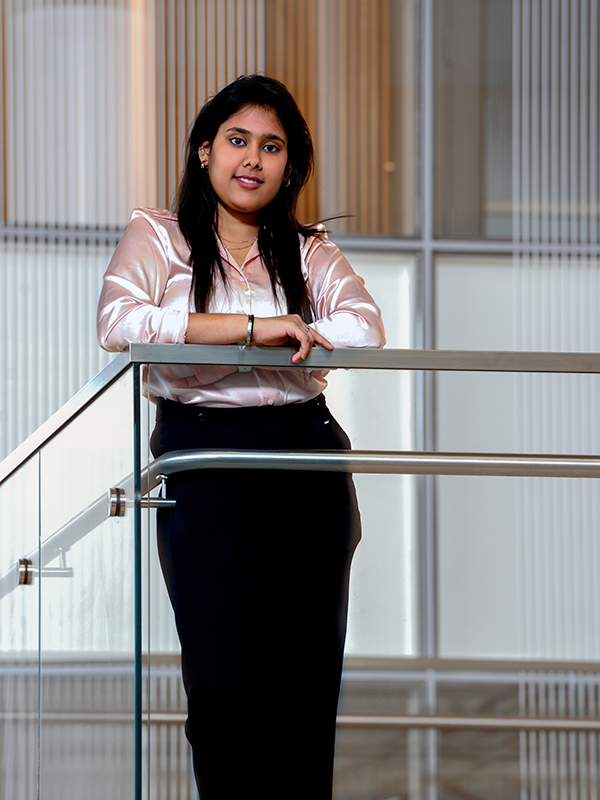Purvi Garg

Michigan State University College of Natural Science
Dean's Research Scholar
In my own words
More about me
What is your hometown?
Mandsaur, India
What is your major and anticipated graduation?
Astrophysics and Data Science (August 2026)
How did you decide to attend MSU?
I came to MSU by luck. In my final year of high school, while at boarding school, I stumbled across a group of students headed to a counselor's office and joined them, which led me to learn about studying in the US. Later, after MSU accepted me, I was drawn to their impressive astronomy program, the planetarium, the observatory, and the opportunity to learn from some of the best professors in the field.
How did you select your major?
During my high school years, particularly as a junior and senior, a certainty took hold of me – a realization that I was destined for astrophysics. The excitement of learning about stars and the mysteries of space were areas I was eager to dive into To me, selecting a major was a declaration of passion, an affirmation that I would follow my zeal rather than simply seeking a means to a livelihood.
Can you describe your research?
My research delves into the enigmatic origins of cosmic rays, the most energetic particles in the universe, by utilizing neutrinos as cosmic messengers. Cosmic rays, when accelerated in astrophysical settings, interact with surrounding matter, giving rise to both gamma rays and neutrinos. These neutrinos and gamma rays, unlike cosmic rays, travel in straight paths, making them pristine indicators of their sources. In my study, we focus on examining neutrino emissions from X-ray binaries, establishing a link between the emissions and their electromagnetic counterparts across various wavelengths. By analyzing the correlation between gamma-ray, X-ray, and neutrino light curves, our work aims to shed light on the cosmic processes that drive these emissions, enhancing our understanding of the fundamental forces shaping our universe.
How has your undergraduate experience been impacted by this experience?
My time at MSU opened my eyes to the wonders of astronomy and how research isn't just solo work but a team adventure. Working as a research assistant, I discovered the joy of solving cosmic puzzles and sharing ideas. I had the privilege to present our team’s findings at conferences like the Conference for Undergraduate Women in Physics and the Data Science Conference, culminating in the Undergraduate University Research and Arts Forum (UURAF). I've not only embraced the complexity of particle astrophysics but also the art of scientific communication, conveying complex findings in an accessible way.
Of everything you have experienced at MSU, what has surprised you the most/what is something you never expected?
The most unexpected part of my journey at MSU has been how captivating astrophysics turned out to be. People often say it's tough and many students quit by their junior year. It's true—it's not easy, but the professors here make it so engaging that by the time I finished my sophomore year, there was no turning back for me. I've become deeply passionate about it, more than I ever thought I would, and now I'm committed to reaching the highest peaks of education in astrophysics.
If your little brother/sister was coming to MSU, what is one piece of advice you would give them?
Embrace the many options and chances you'll find here. Dive into any field or opportunity that interests you. Explore widely, don't draw comparisons, and don't stress. MSU is a supportive place that will have your back.
Person/People who have inspired you?
My Brother and Neil deGrasse Tyson.
Person you would most like to meet (living or dead)?
Richard Feynman and Neil deGrasse Tyson.
On a Saturday afternoon, what would we likely find you doing?
Studying in my room.
What major research breakthrough of the next decade (not your own, but overall) do you think we will see?
The discovery of extraterrestrial life, either through present-day organisms on exoplanets or evidence of ancient life on Mars.
Plans after graduation?
To attend graduate school to pursue a Ph.D. in astrophysics.
Where do you see yourself in 5 years?
Probably doing some astrophysical research in university and working on my final thesis.
Where do you see yourself in 25 years
I might be at a research place institution/university, working with a team on my research and teaching astronomy.
What are some of your favorite MSU memories?
All-nighters in the library, early morning walks back to the dorm, and serene moments by the banks of the Red Cedar River.
What is the Importance of this scholarship to you personally and to your future career?
As a Dean's Research Scholar, I would have the opportunity to showcase the fascinating astrophysics work happening at MSU to a wider community. A personal ambition of mine is to engage in science outreach, aiming to simplify complex concepts and inspire members from diverse backgrounds to explore and contribute to the field of physics. It would also facilitate my aspiration to mentor and educate upcoming students in astronomy, thereby nurturing the next generation of scientists. Moreover, the financial assistance and recognition that come with the scholarship would empower me to delve more profoundly into my chosen field, fostering both academic and professional growth.